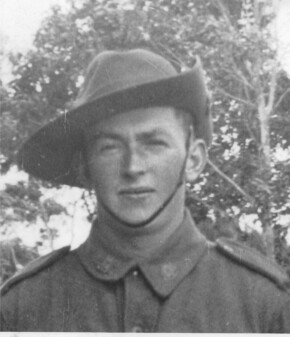KINGSMILL, Desmond Heneage
| Service Number: | VX30473 |
|---|---|
| Enlisted: | 6 June 1940 |
| Last Rank: | Private |
| Last Unit: | 2nd/8th Infantry Battalion |
| Born: | Grangemouth, Scotland, 6 May 1921 |
| Home Town: | Not yet discovered |
| Schooling: | Not yet discovered |
| Occupation: | Not yet discovered |
| Memorials: | Ballarat Australian Ex-Prisoners of War Memorial |
World War 2 Service
| 6 Jun 1940: | Enlisted Australian Military Forces (WW2) , Private, VX30473, 2nd/8th Infantry Battalion | |
|---|---|---|
| 8 Aug 1945: | Discharged Australian Military Forces (WW2) , Private, VX30473, 2nd/8th Infantry Battalion |
Captured in Crete
Like a lot of returned veterans, Des didn't talk much but he did tell a few stories about his time on Crete.
To put it into context the following (taken from the 2/8 Wikipedia page) is an overview of the 2/8th Battalions actions leading to the evacuation form Crete.
After a month long voyage as part of a large convoy carrying Australian troops to the Middle East, the 2/8th reached El Kantara, in Egypt, on 18 May 1940. Upon arrival, the battalion concentrated at the Australian camp at Kilo 89, near Gaza, in Palestine, where it joined the rest of the 19th Brigade. It undertook further exercises and training in Egypt and Palestine prior to the Australians being committed to the fighting against the Italians in the Libyan desert in January 1941 during Operation Compass. A series of actions were fought by the Australians around Bardia and Tobruk, before the 19th Brigade entered Benghazi in February. The 2/8th Battalion had only a minor role in the early battles, but was heavily involved in the fighting for Tobruk, being thrown into an attack against an Italian strong hold that was supported by armour. In April 1941, as the Allies grew concerned about a German invasion of Greece, a combined force of British, Australian and New Zealand troops were deployed there from North Africa. Amidst freezing temperatures, the battalion took part in the fighting around Vevi, in northern Greece near the border with Yugoslavia,[10] before the Australians were pushed back by a larger force. A series of withdrawals followed, during which the 2/8th lost most of its equipment and was broken up into several groups. As the Germans overran the country, the 2/8th was evacuated at the end of the month via Kalamata; part of the battalion – almost 200 personnel – were moved by sea back to Egypt, while the rest – almost 400 personnel – were landed on the island of Crete from Royal Navy destroyers, having originally embarked upon the Costa Rica, which had been sunk en route by several Axis dive-bombers.
They subsequently took part in the fighting on Crete following the German invasion on 20 May. Allocated to the Chania region, the battalion – temporarily under the command of Major Arthur Key – reinforced the British around Perivolia and Mournies, before fighting to hold the line to the west Perivolia as the 19th Brigade was temporarily reorganised to include the 2/7th Battalion and the 2nd Greek Battalion, under the command of Brigadier George Vasey. The battalion was later involved in the fighting around 42nd Street, where the 2/7th and the Māori Battalion launched a ferocious bayonet assault against a German force.] As the Allies withdrew towards Sphakia where the Royal Navy was attempting an evacuation, the battalion formed part of the rearguard along with the 2/7th and some Royal Marines and artillerymen, before they were temporarily reassigned to the New Zealand 5th Infantry Brigade and with them had taken up positions around the Sphakia Gorge at the end of May as the final stage of the evacuation began. A total of 203 personnel from the 2/8th subsequently embarked on the cruiser Phoebe and destroyer Jackal in the final lift on the morning of 1 June. The 2/7th was not so lucky, with all but handful being left behind to become prisoners of war.[17]
Des mentioned the heavy fighting and in particular how easy it was to shoot the German paratroopers while they were hanging from their chutes. He wouldn't elaborate any more
As you can see 2/8 were the rearguard and subsequently Des found himself trying to get to the Port. HE stole a Motorcycle with sidecar and was en route to the port with another soldier when an ME 109 strafed them, killing the sidecar passenger and hitting Des in the left leg breaking his Tibia & Fibula. An Aussie Doctor found him and bandaged him up as best he could, taking some maggots from a nearby dead body shoving them inside his bandage. When the Germans captured him a day or so later and on inspection of the wound the maggots had eaten any dead flesh and kept his wound clean and free of infection.
Des was adamant that the bravest people on the Island were the Aussie Doctors who stayed behind to tend to the wounded until they too were captured.
So on or about 30 May1941 Des was captured and spent the next 4 years in German Hospitals and POW camps.
Submitted 1 May 2024 by Peter Rowley










